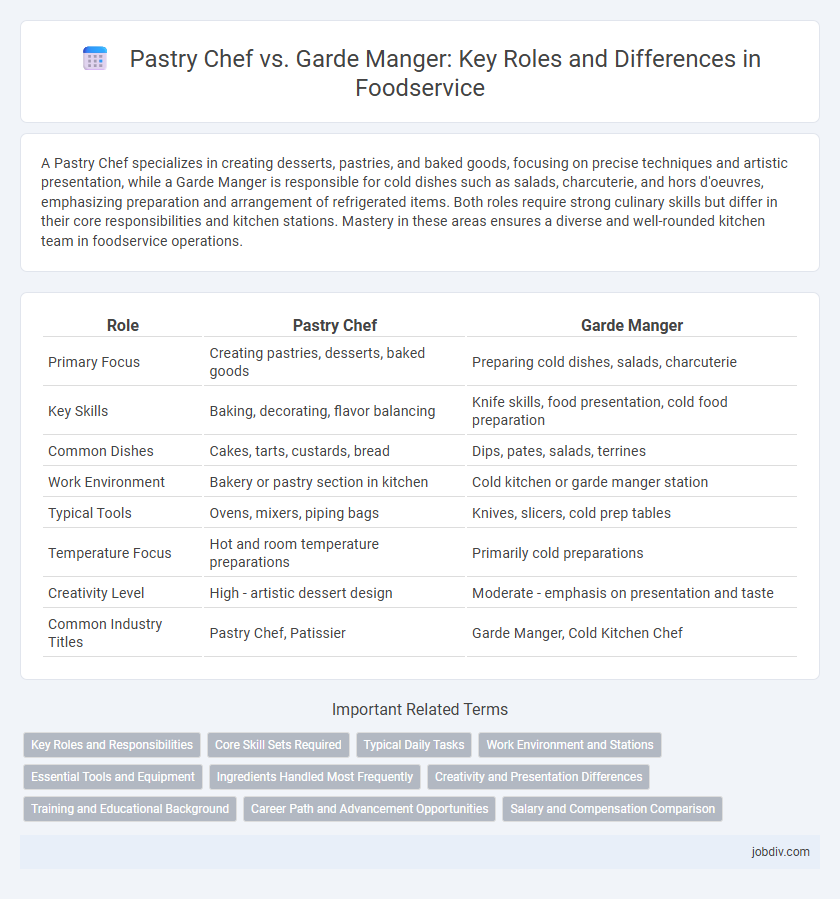A Pastry Chef specializes in creating desserts, pastries, and baked goods, focusing on precise techniques and artistic presentation, while a Garde Manger is responsible for cold dishes such as salads, charcuterie, and hors d'oeuvres, emphasizing preparation and arrangement of refrigerated items. Both roles require strong culinary skills but differ in their core responsibilities and kitchen stations. Mastery in these areas ensures a diverse and well-rounded kitchen team in foodservice operations.
Table of Comparison
| Role | Pastry Chef | Garde Manger |
|---|---|---|
| Primary Focus | Creating pastries, desserts, baked goods | Preparing cold dishes, salads, charcuterie |
| Key Skills | Baking, decorating, flavor balancing | Knife skills, food presentation, cold food preparation |
| Common Dishes | Cakes, tarts, custards, bread | Dips, pates, salads, terrines |
| Work Environment | Bakery or pastry section in kitchen | Cold kitchen or garde manger station |
| Typical Tools | Ovens, mixers, piping bags | Knives, slicers, cold prep tables |
| Temperature Focus | Hot and room temperature preparations | Primarily cold preparations |
| Creativity Level | High - artistic dessert design | Moderate - emphasis on presentation and taste |
| Common Industry Titles | Pastry Chef, Patissier | Garde Manger, Cold Kitchen Chef |
Key Roles and Responsibilities
Pastry chefs specialize in creating baked goods, desserts, and intricate pastries, focusing on precise measurements, decoration, and flavor balance to deliver visually appealing and delicious desserts. Garde manger chefs manage cold food preparation, including salads, charcuterie, pates, and appetizers, ensuring freshness, presentation, and hygiene standards are maintained. Both roles demand strong culinary skills, creativity, and strict adherence to food safety regulations within the foodservice environment.
Core Skill Sets Required
Pastry chefs master precise baking techniques, creativity in dessert presentation, and advanced knowledge of ingredients like sugar and chocolate to create intricate pastries and confections. Garde manger chefs excel in cold food preparation, including charcuterie, salads, and cold appetizers, requiring skills in knife handling, food preservation, and artistry in plating. Both roles demand strong culinary fundamentals, attention to detail, and a deep understanding of flavor balance specific to their specialty areas.
Typical Daily Tasks
Pastry chefs focus on creating desserts, breads, and pastries, involving precise measurements, mixing, baking, and decorating to ensure consistent quality and presentation. Garde Manger chefs prepare cold dishes such as salads, charcuterie, and appetizers, managing tasks like ingredient selection, portioning, and artistic plating. Both roles require meticulous attention to hygiene, inventory management, and coordination with kitchen staff to maintain efficiency during service.
Work Environment and Stations
Pastry Chefs typically work in bakery or dessert-focused stations within the kitchen, requiring precise temperature control and specialized equipment such as ovens, mixers, and refrigeration units. Garde Manger chefs operate in cold stations dedicated to preparing salads, charcuterie, and appetizers, often featuring prep tables, refrigerated counters, and storage for fresh ingredients. Both roles demand a clean, organized workspace but differ significantly in tools, temperature needs, and culinary focus within the foodservice environment.
Essential Tools and Equipment
Pastry chefs rely on specialized tools such as piping bags, pastry cutters, silicone mats, and precision ovens to create delicate desserts and baked goods. Garde manger chefs utilize equipment like mandolins, food processors, blowtorches, and large refrigeration units to prepare cold dishes including charcuterie, salads, and appetizers. Both roles require precision knives and mixing bowls, but their essential tools reflect the distinct culinary techniques inherent in pastry and cold food preparation.
Ingredients Handled Most Frequently
Pastry chefs primarily handle ingredients such as flour, sugar, butter, eggs, and various flavorings to create baked goods, desserts, and confections, emphasizing precise measurements and temperature control. Garde manger chefs focus on cold ingredients including cured meats, cheeses, fresh vegetables, herbs, and seafood, specializing in salads, charcuterie, and cold appetizers. Both roles require expert knowledge of ingredient freshness and storage, but their ingredient palettes serve distinct culinary purposes within a professional kitchen.
Creativity and Presentation Differences
Pastry Chefs specialize in crafting intricate desserts and baked goods, emphasizing delicate textures, refined flavors, and artistic presentation to create visually stunning and flavorful sweet dishes. Garde Mangers focus on cold preparations such as salads, charcuterie, and hors d'oeuvres, showcasing creativity through the arrangement, color contrast, and balance of fresh ingredients to enhance visual appeal and taste. The key difference lies in the Pastry Chef's precision with confectionery arts versus the Garde Manger's skillful assembly and plating of cold culinary creations.
Training and Educational Background
Pastry chefs typically undergo specialized culinary training focused on baking techniques, pastry arts, and dessert preparation, often attending culinary schools with dedicated pastry programs or completing apprenticeships under experienced pastry chefs. Garde Manger chefs usually receive comprehensive culinary education that includes cold food preparation, charcuterie, and salad composition, emphasizing knife skills and food preservation methods, often through general culinary institutes or on-the-job training in high-volume kitchens. Both roles require foundational knowledge of food safety and sanitation, but pastry chefs prioritize precision in measurements and ingredient chemistry, while garde manger chefs focus on artistic presentation and flavor balance in cold dishes.
Career Path and Advancement Opportunities
Pastry chefs specialize in creating desserts and baked goods, often advancing to executive pastry chef positions or opening their own bakeries. Garde manger chefs focus on cold dishes like salads and charcuterie, with opportunities to become sous chefs or head chefs in high-end kitchens. Both career paths offer growth through experience, formal culinary training, and leadership roles within foodservice establishments.
Salary and Compensation Comparison
Pastry chefs typically earn an average annual salary ranging from $35,000 to $50,000, with variations depending on experience and establishment prestige, while garde manger chefs usually receive slightly lower compensation, averaging between $30,000 and $45,000 per year. Benefits packages in high-end restaurants often include health insurance, performance bonuses, and paid time off, with pastry chefs more frequently qualifying for higher incentive pay due to specialized skill sets. Geographic location and restaurant type significantly influence earning potential, with urban fine-dining venues offering the most competitive salaries for both roles.
Pastry Chef vs Garde Manger Infographic

 jobdiv.com
jobdiv.com